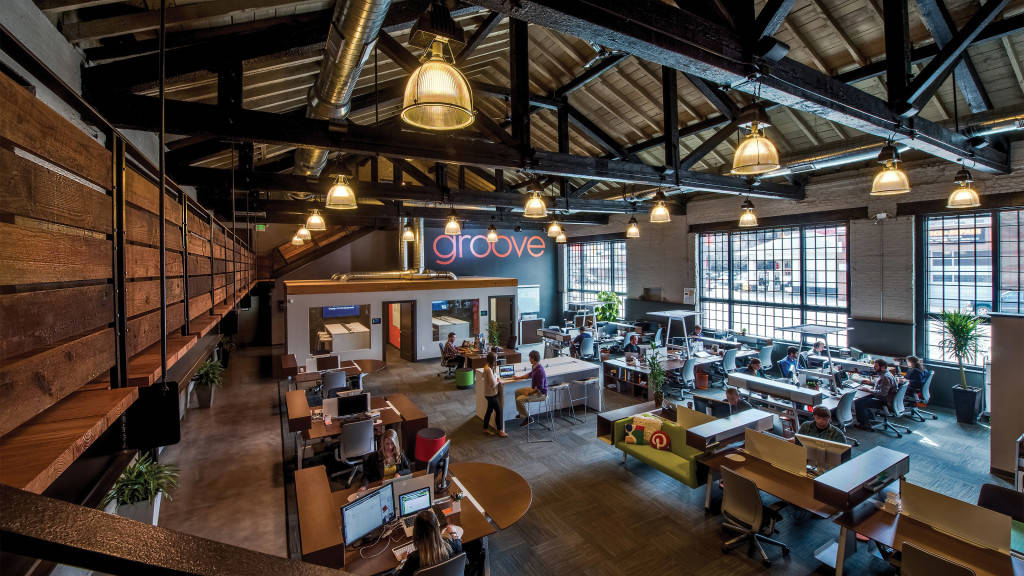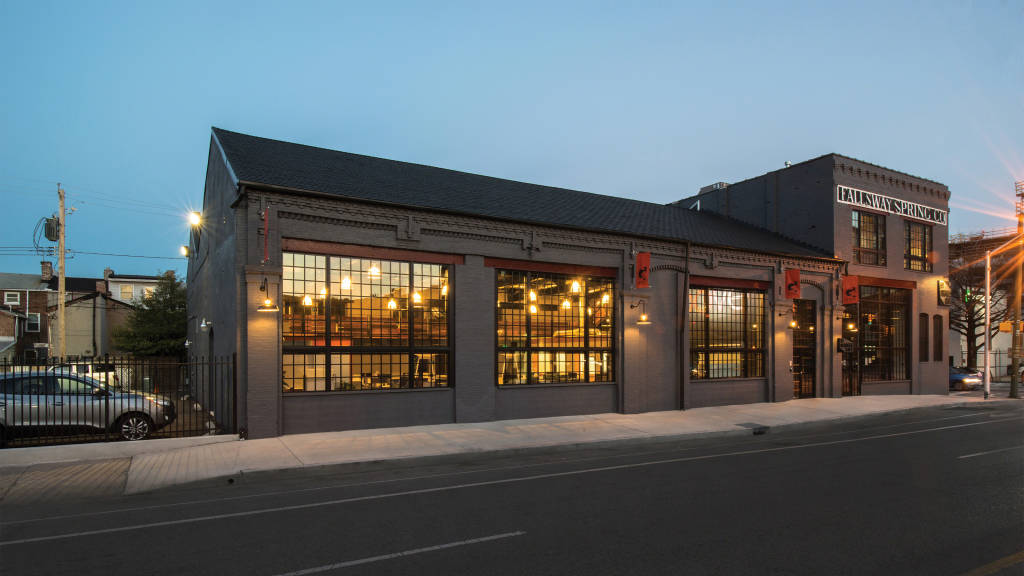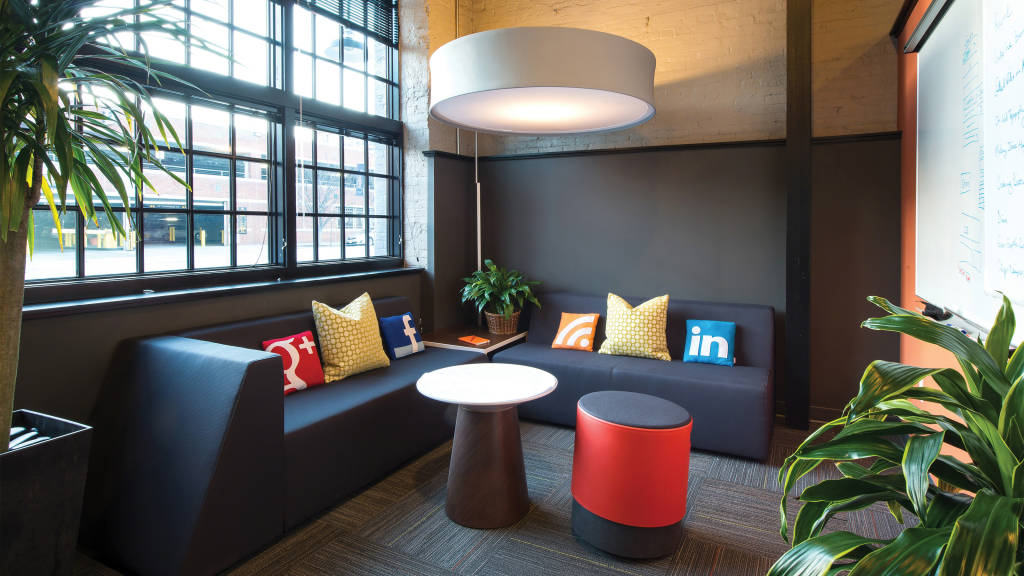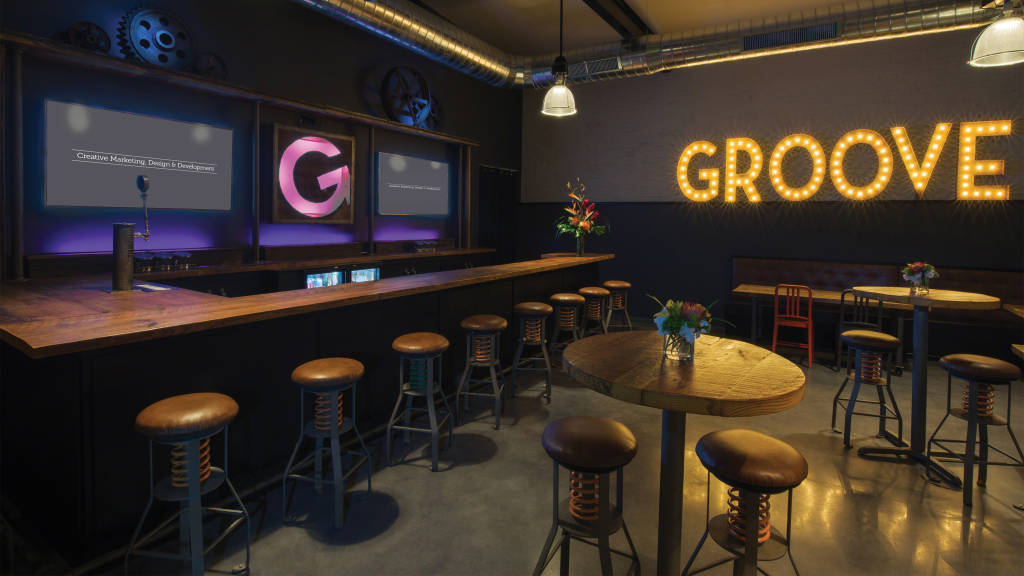Groove
Because most of Groove’s work is collaborative in nature, the majority of the new space is designed for co-creation and brainstorming. Nicknamed “the pit,” this main area is open and collaborative, uniting the team.
For many, noisy copy machines, ringing phones and chatty coworkers are hallmarks of vibrant workplaces. But even in industries like advertising and marketing where creative thinkers thrive on group brainstorming and ideation, it’s easy to overdose on constant noise and togetherness. Creative thinking also requires breakaway time to focus and recharge.
When Groove, a digital advertising and marketing agency in Baltimore, Md., outgrew its space, founder and CEO Ethan Giffin recognized it was an opportunity to rethink the company’s work environment and that the solution involved more than just adding square footage. Partnering with turnstone and Steelcase Baltimore dealer Hyperspace, he took time to examine needs for growing the business in light of the types of spaces necessary for maximizing employees’ success. A top priority was creating an engaging work environment where his team could thrive and do their best work.

10,000 Square Feet of Possibilities
When Giffin first toured an empty industrial building near Baltimore’s Little Italy, he was greeted with crooked walls and dirt floors strewn with debris. But what he saw beyond that was 10,000 square feet of possibilities.
It was 2012 and Groove was not yet seven years old. Having already moved three times, the Groove team was well-acquainted with the pitfalls of underperforming spaces: loud mechanical sounds drowned out conversations and made phone calls difficult: poorly designed spaces left his team in discomfort and unable to concentrate.
The new space had to be different. “I knew we had to evolve from our old way of doing things,” Giffin says. “When I was evaluating everything in our culture, the one thing we were missing was the building—the physical space. We always took someone else’s second-hand space and just repainted it. I came to realize that space was the thing that was missing to push us to the next level creatively.”
As part of his exploration, Giffin visited Steelcase Global Headquarters in Grand Rapids, Mich. The visit radically transformed his thinking about the workplace. After witnessing people working effectively while walking on a treadmill or in informal lounge spaces, he realized work no longer had to be confined to a desk or a boardroom.

Making Space Matter
Inspired by what he saw, Giffin discarded initial plans for a cubicle layout and replaced it with a floor plan that addressed the diverse needs of his team with various types of spaces.
Because most of Groove’s work is collaborative in nature, the majority of the new space is designed for cocreation and brainstorming. Nicknamed “the pit,” this main area is open and collaborative, uniting the team. Employees have assigned desks, but they also have access to a variety of other spaces for collaboration as well as focused work.
For example, they can sneak away to one of Groove’s “dens” on the second-floor loft. Open to the pit below, these dens resemble residential living rooms without walls. Their location provides physical separation from the group without being completely closed off. Enclosed conference rooms offer additional getaway options for team members needing uninterrupted time or a quiet place to work. Whether they need to make phone calls, review a performance evaluation or simply hit a deadline, Groove provides employees with ample enclaves for reservation or impromptu use.
Groove’s in-house bar not only provides additional areas for collaboration but hits a homerun when it comes to fostering vibrant office culture. With beer on tap, a stage complete with disco ball and enough reclaimed wood for an old-fashioned barn raising, the bar sends a clear message that this team likes to have fun. Groove also offers free lunch each Friday, happy hour after work on Friday afternoons, and movie nights regularly.
Groove reinforces their philosophy of options and control by using a music management system that allows for choosing the genre and volume in seven different areas of the building. For example, the pit may feature rap music, while Beethoven plays in the den, but, ultimately, it’s up to the team. Releasing control of environmental factors like this underscores the importance of each individual seeking out the right experience for their tasks.
“The space we have now has elevated our culture. If you look at the excitement of my team and the things we can do, it’s not a stretch to say that this space is responsible for solidifying our culture.” Giffin says.

Private Offices Based on Work
For Giffin, creating a range of places meant preserving a traditional office for himself and Mack McGee, executive vice president and principal of Groove. Their personal workstyles, the confidential nature of some of their projects and the strategies that they are considering for the future are things that they wanted to keep out of the public eye. Client expectations were another factor in that decision.
“My clients expect me to have a formal office,” Giffin notes. “I need space to spread out and my creative work is sometimes more private in nature. I like to think through things alone sometimes and so does Mack.”
He also placed the sales team in a separate room with a door so that ringing phones and chatter don’t disturb the creative team in the pit below. Although Groove employees actively use headphones to achieve privacy, experience has taught Giffin that headphones alone are not always enough. He realized he could maximize team contributions if individuals could go to a different type of space when they need more privacy.
I finally “got it” – work didn’t have to include a desk and a computer tower.
Ethan GriffinCEO of Groove
Space as a Perk and Catalyst
Groove’s journey has so impacted the way they work that their space is listed as a job perk on their website. And having “the coolest space in Baltimore” is not only good for employees; it’s good for business, too.
When it comes to attracting the best in the field, job candidates regularly choose to sign with Groove because they’ve fallen in love with the space, says Giffin. In fact, he’s predicting that, in a matter of years, he won’t need to rely on recruiters to hire mid- or high-level employees.
Equally as exciting is the change he’s seen in the company’s bottom line. Because their old space didn’t represent the brand well, Groove did everything they could to deflect business meetings to alternative venues, email or phone calls. That’s all changed.
“We have clients and prospects in every week. Bringing people here is a different kind of sell—we create an experience for staff, clients and prospects. Now there’s so much traffic, we need a receptionist! And the best part is we’re closing 75-80 percent of business when we can get them into our space. They recognize that if we pay this much attention to our work environment, we’re going to pay even more attention to their project. They’re right.”



